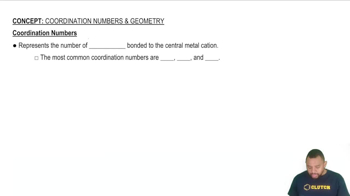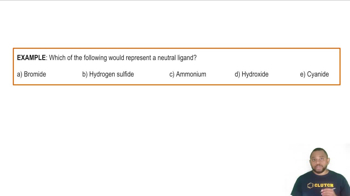Ch.23 - Transition Metals and Coordination Chemistry

Brown15th EditionChemistry: The Central ScienceISBN: 9780137542970Not the one you use?Change textbook
Chapter 23, Problem 25
Complete the exercises below. Indicate the coordination number and the oxidation number of the metal for each of the following complexes: a. Na₂ [CdCl₄] b. K₂ [MoOCl₄] c. [Co(NH₃)₄ Cl₂] Cl
 Verified step by step guidance
Verified step by step guidance1
Step 1: Understand the structure of coordination complexes. A coordination complex consists of a central metal atom or ion bonded to surrounding molecules or ions, known as ligands. The coordination number is the number of ligand donor atoms bonded to the central metal, while the oxidation number is the charge of the metal after accounting for the charges of the ligands and any overall charge on the complex.
Step 2: Analyze complex (a) Na₂ [CdCl₄]. The complex ion is [CdCl₄]²⁻. The coordination number is determined by counting the number of Cl⁻ ligands attached to Cd, which is 4. To find the oxidation number of Cd, note that each Cl⁻ has a charge of -1, and the overall charge of the complex ion is -2. Set up the equation: x + 4(-1) = -2, where x is the oxidation number of Cd.
Step 3: Analyze complex (b) K₂ [MoOCl₄]. The complex ion is [MoOCl₄]²⁻. The coordination number is determined by counting the number of ligand donor atoms: 1 from O and 4 from Cl, totaling 5. To find the oxidation number of Mo, note that O typically has a charge of -2 and each Cl⁻ has a charge of -1. Set up the equation: x + (-2) + 4(-1) = -2, where x is the oxidation number of Mo.
Step 4: Analyze complex (c) [Co(NH₃)₄ Cl₂] Cl. The complex ion is [Co(NH₃)₄ Cl₂]⁺. The coordination number is determined by counting the number of ligand donor atoms: 4 from NH₃ and 2 from Cl, totaling 6. To find the oxidation number of Co, note that NH₃ is neutral and each Cl⁻ has a charge of -1. Set up the equation: x + 4(0) + 2(-1) = +1, where x is the oxidation number of Co.
Step 5: Solve the equations from Steps 2, 3, and 4 to find the oxidation numbers of Cd, Mo, and Co, respectively.
Key Concepts
Here are the essential concepts you must grasp in order to answer the question correctly.
Coordination Number
The coordination number refers to the number of ligand atoms that are directly bonded to a central metal atom in a coordination complex. It is a crucial concept in coordination chemistry, as it helps determine the geometry and stability of the complex. For example, in the complex [Co(NH₃)₄Cl₂]Cl, the coordination number of cobalt is 6, as it is surrounded by four ammonia ligands and two chloride ligands.
Recommended video:
Guided course

Coordination Numbers
Oxidation Number
The oxidation number, or oxidation state, indicates the degree of oxidation of an atom in a compound. It is essential for understanding the electron transfer processes in redox reactions and for determining the charge of the metal in coordination complexes. In the complex Na₂[CdCl₄], the oxidation number of cadmium (Cd) is +2, as it balances the -1 charges from the four chloride ions.
Recommended video:
Guided course

Oxidation Numbers
Ligands
Ligands are ions or molecules that can donate a pair of electrons to a central metal atom to form a coordination complex. They play a significant role in determining the properties and reactivity of the complex. In the complex K₂[MoOCl₄], the ligands include the oxo group (O) and chloride ions (Cl), which influence the oxidation state of molybdenum (Mo) and its coordination environment.
Recommended video:
Guided course

Ligands Example
Related Practice
